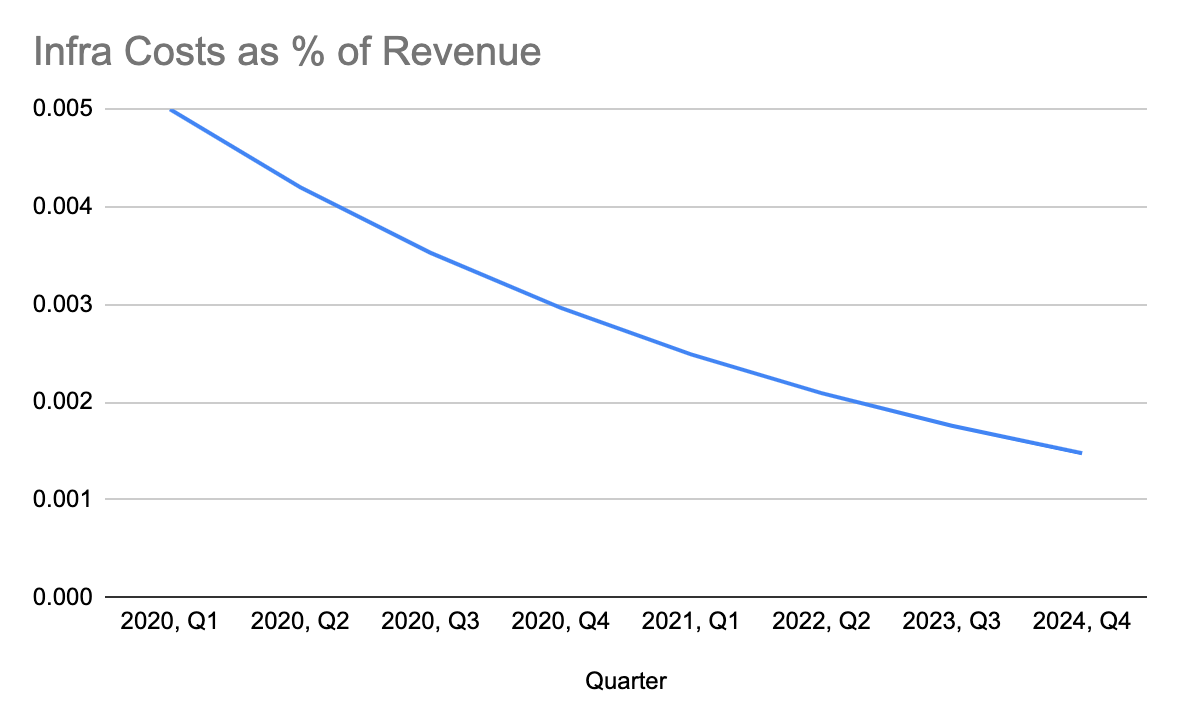Should you prioritize infrastructure costs?
This is an exerpt from Infrastructure Engineer’s section on efficiency.
Before diving into the mechanics of managing infrastructure costs, the first question to answer is whether it’s a valuable use of organizational time to make your current infrastructure spend more efficient. How you think about this will vary a bit depending on whether your company is early-stage, prioritizing growth or profitability.
Early-Stage
Generally speaking, very early-stage companies shouldn’t spend much time thinking about infrastructure costs. You should instead be focused on finding product-market fit for your first product.
Here are two checks you can run to determine if it’s worth reducing your infrastructure costs:
- If you were to reduce your infrastructure costs to $0, and it still doesn’t increase your runway by at least two months, then it’s not worth focusing on
- If you’re spending less than $2,000/month per employee on infrastructure costs, then it’s probably not a significant priority because your headcount spend will be so much higher
If you’re not violating either of those checks, then keep on ignoring infrastructure spend. If you are exceeding one, and infrastructure costs are a significant part of your overall burn, then invest a sprint into reducing spend, and then stop ignoring it once these checks resume passing.
The one notable exception is if you’re building a low-margin product or product where cost efficiency is a pillar of your long-term strategy. For example, if you’re operating a metrics collection and dashboarding product like Datadog, then efficiency probably is worth considering earlier than usual.
Growth
When you’re prioritizing growth, the primary focus of the engineering organization in a technology company is creating, operating and advancing the products that support the business. Managing costs is important, but even immaculate cost management won’t make your company a success if enough energy isn’t being invested in your product.
The fundamental question to ask is whether infrastructure’s share cost of goods sold (COGS) are increasing as a percentage of revenue? (The simplest way to think COGS is all your non-headcount costs, although a slightly better definition would be all costs to operate

Start answering this question by plotting revenue and infrastructure costs on a chart to get a sense of how these two numbers are moving. Although logarithmic scales often generate more confusion than they’re worth, in this case it’s usually the only way to see both lines closely enough to understand their slopes within a single chart. You particularly want to understand if either line has experienced an inflection over the past few quarters. If costs have started accelerating without corresponding acceleration of revenue, that’s worth digging into.

Once you’ve looked at the two lines independently to understand their movement, simplify your first chart into a chart showing infrastructure costs as a percentage of revenue. This chart hides some detail but is easier to parse for folks further away from the details. As long as the ratio is going down and you’re company is focused on growth, then this data should be sufficient to justify your current level of investment into efficiency: if growth is key, and infrastructure costs are not getting in the way, why should you slow down growth to reduce them?
Profitability
Even the best business lines stop growing at some point. Facebook is one of the most valuable businesses in the world, but even they at some point ran out of new users to attract to their platform. Once growth slows, a business naturally starts focusing more on costs, including infrastructure spend.
In those scenarios, the easiest approach is to work with the business to align on two numbers:
- Dollars spent on infrastructure overhead per engineer: this includes things like development environments, testing tools, and so on. Determine your starting point by bucketing vendors and non-production infrastructure costs into a chart and plotting them over time divided by headcount. Pick a reasonable point on that line as your target. Refine it by reaching out to industry peers to get a sense of how this number compares to theirs (be sure to pick industry peers in companies that are currently focused on profitability, otherwise their answers won’t be very helpful to you)
- Infrastructure dollars spent per N product operations served: anchoring on cost of operating the product. This will vary a bit depending on your product or business, but it might be “$1.00 in infrastructure costs to powering every 10,000 searches”, “$2.50 for every 10,000 payments processed”, or “$3.00 for every 10,000 trips scheduled”
In both, the key thing is moving away from anchoring on a percentage of revenue and instead setting a target against the fundamental operations that you support. Thinking of costs as a percentage of revenue works well when you’re growing, but is too abstract and hides too many details once you’re focused on reducing costs.
If you find yourself exceeding those targets, then it’s time to dive into reducing them.